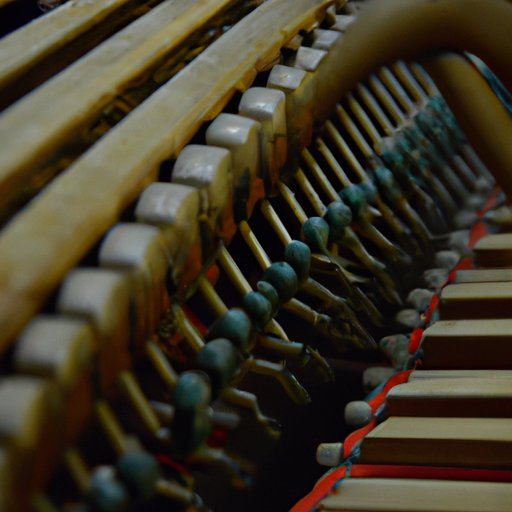Introduction
The piano is one of the most beloved instruments in the world. Its sound has captivated listeners for centuries, and it’s still used today in many types of music. But how does a piano actually work? In this article, we’ll explore the mechanics of a piano, from its anatomy to the science behind its sound.
Anatomy of a Piano
A piano consists of three main components: keys, hammers, and strings. The keys are what the player presses to produce a sound. When the key is pressed, it moves the hammer, which then strikes the string. The vibration of the string then produces a sound.
Keys
At the heart of the piano are its keys. Each key is connected to a small piece of wood called a “hammer”, which is connected to a metal rod called a “hammer shank”. As the player presses the key, the hammer shank moves the hammer towards the string.
Hammers
The hammers are made of felt and are designed to strike the strings with the right amount of force. The force of the strike determines the volume of the note. The softer the strike, the quieter the note; the harder the strike, the louder the note.
Strings
The strings are made of steel and are tuned to specific pitches. When the hammer strikes the string, it vibrates, producing a sound. The length of the string determines the pitch of the note. The longer the string, the lower the pitch; the shorter the string, the higher the pitch.
The Science Behind a Piano’s Sound
The science behind a piano’s sound is complex, but it can be broken down into two main concepts: the physics of music and tone production.
Physics of Music
The physics of music is the study of how sound waves travel and interact with each other. This includes the study of acoustic resonance, which is the phenomenon of sound waves bouncing off of objects in the environment. It also includes the study of harmonics, which are the different frequencies that make up a single sound.
Tone Production
Tone production is the study of how a piano’s strings vibrate to produce different sounds. This includes understanding the relationship between the length of the string, the tension on the string, and the rate of vibration of the string. It also includes understanding the relationship between the force of the hammer strike, the type of hammer material, and the amount of energy transferred to the string.
Understanding a Piano’s Musical Components
In addition to the keys, hammers, and strings, there are several other components that make up a piano. These include the keyboard design, the pedals, and other features such as the soundboard, dampers, and pedals.
Keyboard Design
The keyboard design of a piano is essential to its sound. The layout of the keys determines the range of notes that can be played. The size of the keys affects the accuracy of the player’s performance. And the weight of the keys affects the touch sensitivity of the instrument.
Pedals
Most pianos have three pedals: the sustain pedal, the soft pedal, and the sostenuto pedal. The sustain pedal allows notes to be held for longer periods of time. The soft pedal reduces the volume of the notes. And the sostenuto pedal allows certain notes to be sustained while others remain unaffected.
The History of the Piano
The piano was invented in the early 1700s by Italian instrument maker Bartolomeo Cristofori. He developed the first version of the instrument, which he called the “Pianoforte”. Over the years, the piano has evolved into the modern instrument we know today. It has been featured in countless musical works, from classical to jazz to pop.
Conclusion
The piano is an incredible instrument with a fascinating history. By exploring the mechanics of a piano, we can better understand how this wonderful instrument works. From its keys and hammers to its strings and pedals, the mechanics of a piano are essential to its sound and its ability to produce beautiful music.
(Note: Is this article not meeting your expectations? Do you have knowledge or insights to share? Unlock new opportunities and expand your reach by joining our authors team. Click Registration to join us and share your expertise with our readers.)
